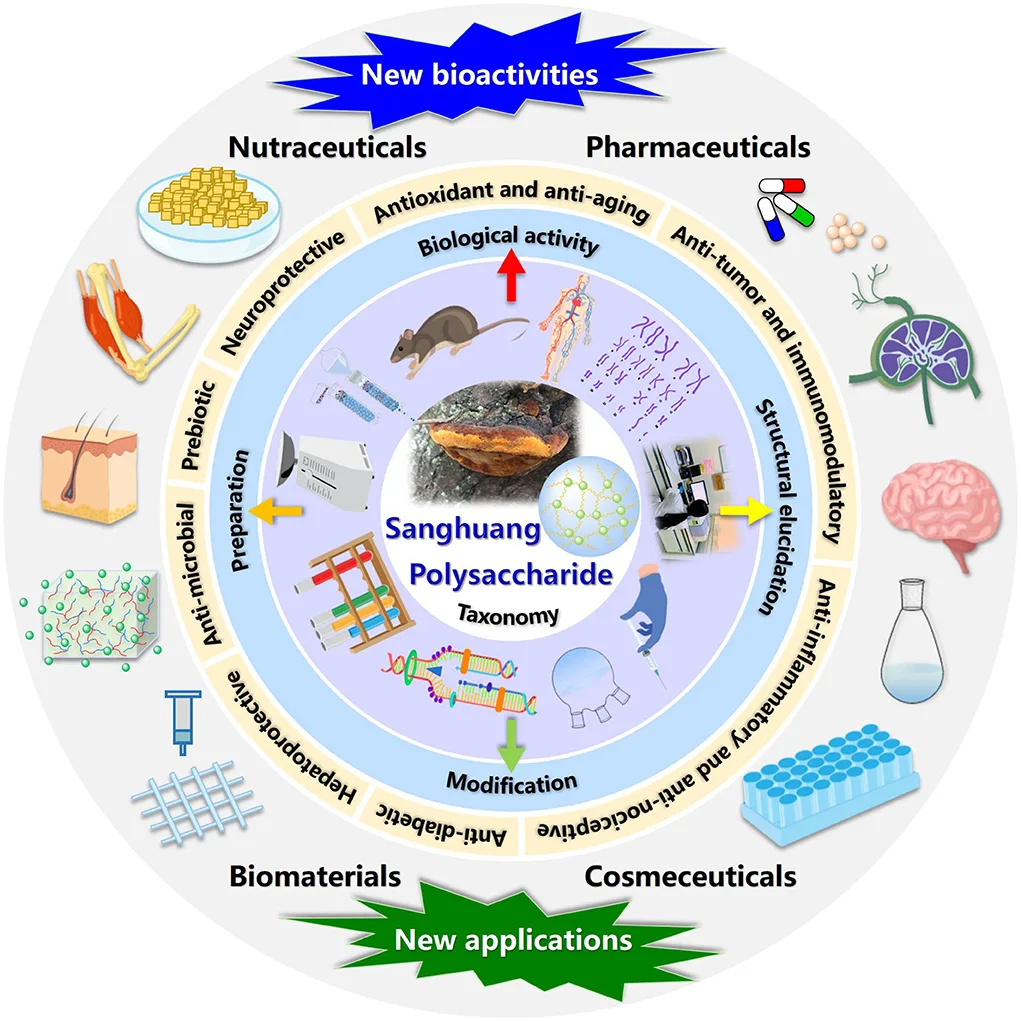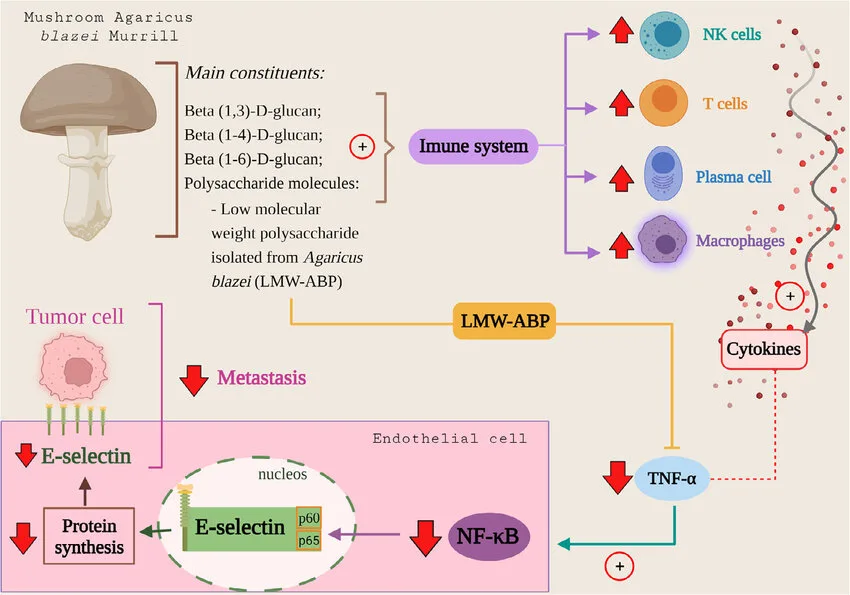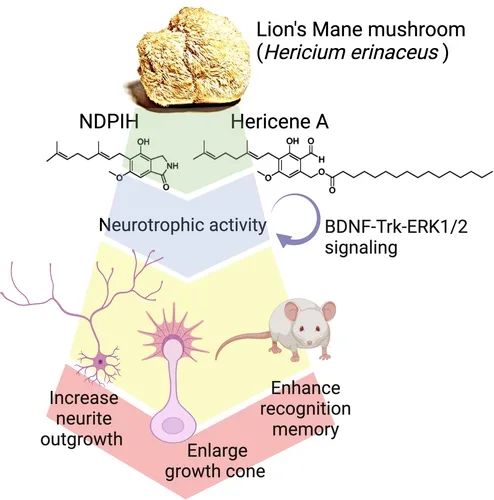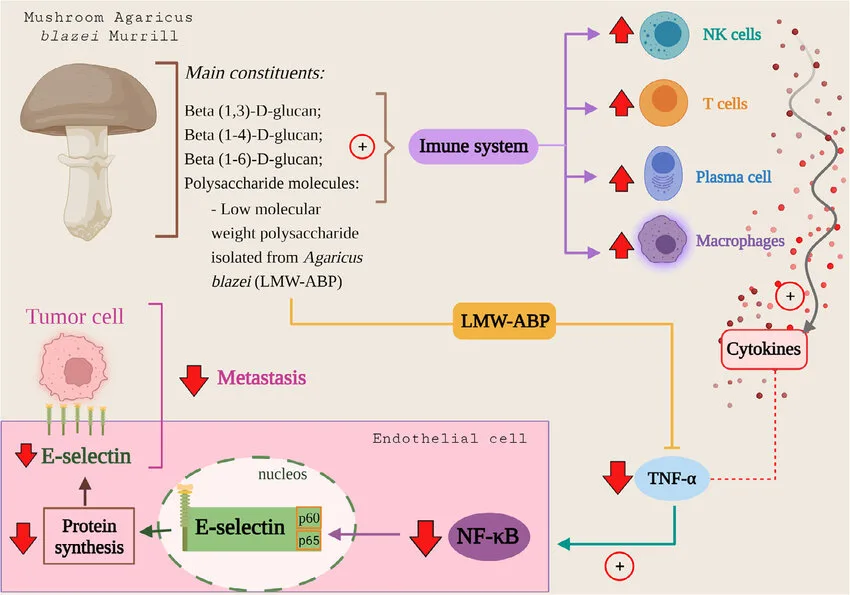At current, there are 15,000 species of enormous fungi on the planet, of which greater than 2,000 are edible fungi, and greater than 1,000 species of edible fungi have been clearly recorded in China [1]. Mushrooms are wealthy in vitamins and purposeful energetic substances, together with polysaccharides, energetic proteins and peptides, phenols, ketones, terpenes and steroid compounds [2]. Amongst them, polysaccharides are one of many essential energetic substances of edible fungi. Trendy analysis reveals that edible fungi polysaccharides have a wide range of organic actions, together with antioxidant, anti-tumor, anti-inflammatory, immunomodulatory, hypoglycemic, intestinal flora regulation, antiviral and different actions [3]. Edible fungi polysaccharides are used as purposeful energetic substances to forestall and deal with numerous persistent ailments and are very useful to human well being. The creator systematically critiques the efficacy of assorted typical edible fungi polysaccharides and the analysis progress of their utility in purposeful meals, biomedicine and cosmetics, with a view to present reference and scientific foundation for the additional improvement and utilization of edible fungi and their polysaccharides.
Typical edible fungus polysaccharides and their results
Ganoderma lucidum polysaccharides

Ganoderma lucidum is a well-known edible and medicinal fungus with a historical past of hundreds of years of utility. The Pharmacopoeia of the Folks’s Republic of China [4] information that Ganoderma lucidum is “candy and impartial. It enters the center, lung, liver and kidney meridians” and has the consequences of “tonifying qi and calming the thoughts, relieving cough and relieving bronchial asthma”. Polysaccharides are one of many essential parts of Ganoderma lucidum to exert organic exercise. At current, Ganoderma lucidum polysaccharides are primarily derived from spore powder, fruiting our bodies, mycelium and Ganoderma lucidum fermentation liquid. Ganoderma lucidum polysaccharides have antioxidant, anti-tumor, hypoglycemic, anti-inflammatory, liver safety, immunomodulatory and neuroprotective results. Ganoderma lucidum polysaccharides present good antioxidant exercise by scavenging extra free radicals, growing antioxidant enzyme exercise and lowering peroxides [5]. Liu Yang et al. [6] discovered that Ganoderma lucidum polysaccharides can considerably promote the mobile immune response of 4T1 tumor-bearing mice to HER2/neu plasmid DNA vaccine and have a big immune-promoting impact on mice. As well as, Wu Ruiting et al. [7] discovered that black Ganoderma lucidum polysaccharide can considerably regulate blood glucose, blood lipids and insulin in diabetic rats induced by streptozotocin (STZ), and its mechanism could also be by means of altering the structural composition of microorganis Ganoderma lucidumms within the rat gut. Dilisoyer Yalekunmu et al. [8] identified that Ganoderma lucidum polysaccharide might play a radiation safety position by bettering the expression of related potential biomarkers and their associated metabolic pathways within the thymus of radiation mannequin mice.
Cordyceps polysaccharide
Cordyceps polysaccharide is a extremely branched galactomannan. Research have discovered that Cordyceps polysaccharide performs an essential position in bettering immune perform, anti-cancer, sterilization, lung safety, and kidney profit. Jiang Yuzhen et al. [9] optimized the enzyme-assisted sizzling water extraction of Cordyceps militaris polysaccharide by response floor methodology and located that the DPPH free radical scavenging fee of Cordyceps militaris polysaccharide reached 88.06%, and the hydroxyl free radical scavenging fee was 78.80%, each of which have been dose-dependent, proving that Cordyceps militaris polysaccharide has good antioxidant exercise. Yao Yanting et al. [10] obtained Cordyceps militaris polysaccharide fraction (SeCMP0.2) by water extraction and alcohol precipitation mixed with anion change chromatography column separation and purification. The outcomes confirmed that SeCMP0.2 can activate mitogen-activated protein kinase and nuclear factor-κB signaling pathways, upregulate the expression of inducible nitric oxide synthase, tumor necrosis factor-α, interleukin-6, and interleukin-1β mRNA, and exert its immunomodulatory impact. Liu Guangqing et al. [11] extracted Cordyceps flower polysaccharide by water extraction and alcohol precipitation mixed with Sevag technique and located that Cordyceps flower polysaccharide can considerably cut back the expression ranges of tumor necrosis issue α, nuclear issue κB, and so on. in CCl4-induced mouse liver, considerably downregulate serum ALT and AST ranges, alleviate CCl4-induced liver harm, inhibit hepatocyte apoptosis, and supply a reference for the remedy of liver fibrosis.
Phellinus igniarius polysaccharide

Phellinus igniarius can promote diuresis and cease bleeding, enhance inside organs. “Compendium of Materia Medica” [12] information that “Mulberry parasite advantages the 5 inside organs, promotes intestinal and abdomen qi, and removes poisonous qi.” As one of many essential bioactive parts of Phellinus igniarius, polysaccharides have been verified to have a number of organic actions similar to anti-tumor, immunomodulatory, anti-inflammatory, and antioxidant. Zhang Kunlin et al. [13] discovered that Phellinus igniarius polysaccharides can improve the exercise of embryonic alkaline phosphatase secreted by RAW-BlueTM cells and their macrophage phagocytosis, proving that Phellinus igniarius polysaccharides have immune exercise. Miao Yunping et al. [14] used Phellinus igniarius polysaccharides to deal with rat ulcerative colitis induced by 2,4,6-trinitrobenzenesulfonic acid (TNBS). The outcomes confirmed that Phellinus igniarius polysaccharides may considerably cut back the expression ranges of NF-κB p65 protein and IL-6 and TNF-α mRNA within the rat colon. The therapeutic impact on rat ulcerative colitis was apparent, which can be associated to regulating the secretion of inflammatory cytokines, anti-oxidation and inhibiting the expression of NF-κB. Li Yuanyuan et al. [15] ready crude polysaccharide from mycelium of Phellinus igniarius by water extraction and alcohol precipitation, obtained fractions (IPS45-W) by distilled water elution, and located that it may inhibit the expansion of HepG2 cells (the inhibition fee was 57% at a focus of fifty μg/mL) by means of in vitro cytotoxicity and cell viability assessments, proving the anti-tumor exercise of crude polysaccharide from mycelium of Phellinus igniarius. Yu Qiuju et al. [16] discovered that mulberry linterus polysaccharide has good antioxidant and tumor inhibition exercise by means of in vitro exercise assessments.
Grifola frondosa polysaccharide
The polysaccharide parts extracted from Grifola frondosa fruiting our bodies have organic actions similar to antioxidant, anti-tumor, radiation safety and immunomodulatory. Xu Yingying [17] discovered that Grifola frondosa polysaccharide element (GFP1) has a big inhibitory impact on the proliferation of lung most cancers cells H1975, and GFP1 might obtain anti-tumor results by inhibiting the Ras/Raf/MEK/ERK signaling pathway. Tang Mengting [18] used the Illumina system to investigate the construction and composition of the intestinal flora after fermentation of the tradition medium and located that the parts of Grifola frondosa polysaccharide (GFP-H, GFP-L) can considerably promote the proliferation of Bifidobacterium and Bacteroides within the gut, and have a useful impact on the well being of the intestinal flora. Quan Shulin et al. [19] discovered that Grifola frondosa polysaccharide GFP-A1 can considerably enhance the train endurance of train mice and has an anti-fatigue impact. Liu Yonghua et al. [20] discovered that Grifola frondosa polysaccharide can considerably enhance the content material of superoxide dismutase (SOD) and glutathione peroxidase (GSH-Px) in rats with gastric ulcer mannequin, and cut back the degrees of gastrin (GAS), motilin (MTL), somatostatin (SS), and malondialdehyde (MDA), additional proving the position of Grifola frondosa polysaccharide in lowering gastrointestinal hormone secretion and bettering antioxidant ranges.
Agaricus blazei polysaccharide

Research have discovered that Agaricus blazei polysaccharide has organic actions similar to anti-cancer, antioxidant, hypoglycemic, diabetes enchancment, and ldl cholesterol discount. Pu Chao et al. [21] handled CHON-001 cells with 10 ng/mL IL-1β to ascertain a chondrocyte irritation mannequin and explored the protecting impact of Agaricus blazei polysaccharide on interleukin 1β (IL-1β)-induced chondrocyte CHON-001 damage. The outcomes confirmed that Agaricus blazei polysaccharide may considerably cut back the apoptosis fee and Bax protein stage of the chondrocyte irritation mannequin, and identified that IL-1β-induced chondrocyte irritation and apoptosis have been inhibited by upregulating the expression stage of miR-382-3p. As well as, Zhong Pupeng et al. [22] discovered that Agaricus blazei polysaccharide additionally has a sure impact on intestinal barrier safety. They identified that Agaricus blazei polysaccharide can considerably enhance the relative expression of Faecalibacterium prausnitzii, Lactobacillus and Bifidobacterium 16SrRNA genes in rats with ulcerative colitis induced by sodium dextran sulfate (DSS), and considerably cut back the relative expression of Escherichia coli 16SrRNA genes, indicating its essential position in stopping acute colitis.
Hericium erinaceus polysaccharide

Hericium erinaceus is flat in nature, candy in style, wealthy in vitamin, helps digestion and advantages the 5 inside organs. Hericium erinaceus is usually used to enhance peptic ulcers, persistent gastroenteritis, lack of urge for food and different ailments, and likewise has a sure inhibitory impact on most cancers. Hericium erinaceus comprises polysaccharide, which is named “hericium erinaceus polysaccharide”, which has a number of organic actions similar to antioxidant, immunomodulatory, regulating intestinal microbiota, reducing blood sugar, anti-tumor, and gastric safety. Ma Zheng et al. [23] studied the consequences of Hericium erinaceus polysaccharide on the restoration of bodily activity-induced fatigue and antioxidant capability within the aged and located that supplementing Hericium erinaceus polysaccharide within the aged can considerably enhance their cardio capability and blood rheology, promote fatigue restoration, and enhance antioxidant capability. Niu Meilan et al. [24] confirmed that Hericium erinaceus polysaccharide can considerably cut back the degrees of TNF-α, IL-6, and IFN-r within the serum of rats with persistent non-bacterial prostatitis, cut back the degrees of immunoglobulins IgA and IgG within the serum, additional alleviate persistent non-bacterial prostatitis in rats, and delay the event of the illness. Li Xinghai et al. [25] explored the anti-tumor exercise and mechanism of Hericium erinaceus polysaccharide, primarily by culturing gastric adenocarcinoma cells and establishing a Hericium erinaceus polysaccharide addition group. It was discovered that Hericium erinaceus polysaccharide mixed with remodeling progress factor-β1 can successfully inhibit the proliferation of gastric adenocarcinoma cells BGC-823 and SGC7901 by negatively regulating p-AKT and p-PI3K, thereby additional inhibiting the variety of most cancers cell clones.
Poria cocos polysaccharide
Poria cocos is the dried sclerotium of the fungus Poria cocos of the Polyporaceae household. It’s “impartial in nature, candy and lightweight in style, and enters the center, spleen, and kidney meridians. It’s diuretic and dehumidifying, strengthens the spleen, and calms the thoughts. It’s used for edema, oliguria, phlegm and fluid, palpitations, spleen deficiency, poor urge for food, unfastened stools, restlessness, palpitations, and insomnia.” Numerous research have confirmed that Poria cocos polysaccharide has antiviral and anti-tumor results, and reduces the uncomfortable side effects of radiotherapy and chemotherapy. Liu Jiali et al. [26] discovered that Poria cocos polysaccharide can considerably cut back the discharge of NO and the speed of apoptosis in lipopolysaccharide-induced cat kidney cells, and believed that it could obtain the impact of cell irritation safety by inhibiting the TLR4-NF-κB signaling pathway. This analysis outcome gives a brand new goal and experimental foundation for the verification of Poria cocos polysaccharide within the remedy of cat kidney cells. Zheng et al. [27] used sizzling water extraction to acquire Poria cocos polysaccharide (PCPP-1A) and located that PCPP-1A has glorious potential in stimulating the immune response of RAW264.7 cells and defending AML-12 cells from radiation.
Tremella polysaccharide
Tremella is nice in style, impartial in nature, and belongs to the lung meridian. It has the consequences of nourishing yin and moistening the lungs, replenishing qi and selling fluid, and beautifying the pores and skin. The tremella polysaccharide it comprises has the consequences of enhancing immunity, reducing blood sugar, and stopping and treating cardiovascular ailments. Xing Youzhe et al. [28] discovered that tremella polysaccharide can considerably promote the proliferation of mouse spleen lymphocytes, promote the secretion of IL-6, IL-10, IL-12 and IFN-γ, and exert its immunomodulatory impact by activating the PI3K/Akt and NF-κB signaling pathways of mouse spleen lymphocytes. Huang Xiaolan et al. [29] discovered that tremella polysaccharide can considerably cut back the degrees of TNF-α and Il-6 within the serum of mice present process exhaustive train by regulating the Nrf2/HO-1 signaling pathway, considerably enhance the degrees of SOD and GSH-Px, and delay the exhaustive swimming time of mice, proving that tremella polysaccharide improves oxidative harm brought on by train by inhibiting oxidative stress. Tan Minying et al. [30] discovered that Tremella polysaccharide has the impact of inhibiting osteoarthritis, defending cartilage tissue to a sure extent, and resisting cell apoptosis.
Black fungus polysaccharide
Black fungus is “impartial, candy, easy, and enters the abdomen and enormous gut meridians”. It is named the “intestinal scavenger”. It primarily depends on its cleansing, lipid-lowering, intestinal motility promotion, and metabolism enhancement. Black fungus is wealthy in antioxidants and has wealthy organic actions. Black fungus polysaccharide has a number of organic actions similar to antioxidant, lipid-lowering, immune enhancement and anti-tumor. Liu Nannan [31] extracted and purified two black fungus polysaccharide parts (AAP-1 and AAP-2) by sizzling water extraction-ethanol precipitation technique, and used C57BL/6J male mice to assemble a kind 2 diabetes mannequin for in vivo hypoglycemic exercise analysis. It was discovered that each black fungus polysaccharide parts can activate the PI3K/AKT signaling pathway, cut back insulin resistance, cut back oxidative stress harm, and enhance glucose and lipid metabolism to realize the impact of reducing blood sugar. Li Xue et al. [32] ready phosphorylated black fungus polysaccharide liposomes by phosphorylation modification of black fungus polysaccharide, which considerably improved its scavenging fee of DPPH free radicals, proving its antioxidant capability in vitro. It was additionally discovered that the encapsulation of liposomes may successfully stop the oxidation of phosphorylated black fungus polysaccharide. Zhang Tingting et al. [33] discovered that black fungus polysaccharide may considerably enhance the abundance of Rhodococcus or non-digestive saccharobacterium within the fecal flora of SD rats, considerably cut back the abundance of pro-inflammatory micro organism Prevotella, and alleviate hepatitis and different ailments brought on by a high-fat weight-reduction plan. As well as, black fungus polysaccharide may considerably enhance the content material of short-chain fatty acids within the cecum of SD rats. This examine gives concepts for black fungus polysaccharide to enhance blood lipid metabolism.
Utility Standing of Typical Edible Fungi Polysaccharides
Utility in Useful Meals
Edible fungi have distinctive texture and taste. By including edible fungi or edible fungi polysaccharides, the flavour and style of meals could be improved. On the similar time, because of the a number of organic actions of edible fungi and their polysaccharides, they can be utilized as meals uncooked supplies to develop new meals, which cannot solely have an effect on the feel and vitamin of meals, but in addition give new purposeful traits to new merchandise. my nation’s nationwide customary GB 16740-2014 Basic Commonplace for Well being (Useful) Meals factors out that polysaccharides can be utilized because the efficient substances of purposeful well being meals. Among the many well being meals with polysaccharides as the principle substances which were launched in my nation, solely 14 varieties are recorded by the Nationwide Particular Meals Info Question Platform, together with three dosage varieties: capsules, tablets, and oral liquids, masking a wide range of Chinese language natural polysaccharides similar to astragalus polysaccharides and ganoderma lucidum polysaccharides. For instance, Qingfu Ning capsule, Yangpeptide Lingzhi capsule, Tangzhi capsule, and Propolis Lingzhi capsule are developed with Lingzhi polysaccharide because the energetic ingredient, Seabuckthorn Tianbao comfortable capsule is developed with Poria polysaccharide as the principle biologically energetic ingredient, and Cordyceps militaris Lingzhi Milk thistle capsule is developed with Cordyceps militaris polysaccharide as the principle energetic ingredient. In 2001, the Nationwide Well being Fee (previously the Ministry of Well being) launched a listing of 11 fungal species that can be utilized in well being meals [34]. It may be seen that the potential efficacy of edible fungi polysaccharides and purposeful meals constructed from edible fungi polysaccharides must be additional developed.
Meals with a excessive glycemic index (GI) may cause a pointy enhance in blood sugar ranges and result in the prevalence of acute metabolic ailments. The digestion traits of starch are carefully associated to the postprandial blood sugar response. Due to this fact, controlling the absorption fee of starch to regulate the blood sugar stage of the human physique has turn into an efficient scientific vitamin strategy. It’s reported that edible fungi polysaccharides can enhance insulin resistance and successfully cut back starch content material [35-36]. Su Jing[37] used Tremella fuciformis polysaccharide as an energetic ingredient (added at 0.4%), maltitol and isomalt as uncooked supplies, and gelatin as a gelling agent to develop a gel comfortable sweet. Liu et al.[38] studied the consequences of Pleurotus eryngii and lemongrass powder on the bodily and chemical properties, sensory high quality and digestibility of bread. The outcomes confirmed that Pleurotus eryngii powder, as a high-value ingredient, can enhance the dietary high quality of bread and cut back its GI. Solar Fan[39] developed Pleurotus eryngii immune yogurt with the exercise of bettering human immunity based mostly on the immune-enhancing exercise of Pleurotus eryngii polysaccharide. The system is 0.1% Lactobacillus bulgaricus and Streptococcus thermophilus, 0.7% Pleurotus eryngii polysaccharide, 7% white sugar, and 0.2% pectin. This product has the inherent taste of yogurt and the suitable Pleurotus eryngii taste, and the feel and look meet the product high quality requirements. Li Guangfu[40] added ganoderma lucidum polysaccharide, ganoderma acid, tea mushroom polysaccharide and enoki mushroom polysaccharide to yogurt to develop edible fungus polysaccharide yogurt, and located that the in vitro antioxidant and anti-aging results of edible fungus polysaccharide yogurt have been vital. As well as, edible fungus polysaccharides are additionally used to provide purposeful meals similar to well being bread[41], noodles[42], and drinks[43], enjoying an essential position in bettering product taste and vitamin.
Utility within the area of biomedicine
Because of the potential organic exercise of edible fungus polysaccharides, they’re usually used to develop anti-cancer medicine, anti-diabetic medicine, antiviral medicine, prebiotics, immunosuppressive (regulatory) brokers, and so on.[44].
Atpresent, many edible fungus polysaccharides have been developed into injections, tablets, granules, oral liquids, decoction items, syrups, and so on. appropriate for scientific utility. The edible fungus polysaccharide medical merchandise accepted by the Nationwide Medication Requirements contain a variety of varieties. The drug merchandise developed with edible fungus polysaccharides which were utilized in scientific observe embrace Ganoderma lucidum injection, carboxymethyl Poria cocos polysaccharide injection, Polyporus umbellatus polysaccharide injection, Lentinula edodes polysaccharide tablets, Hericium erinaceus tablets, polysaccharide protein decoction items, Ganoderma lucidum dew, compound Ganoderma lucidum dry syrup, Yunzhi Gantai granules, Liangjun tablets, Ganbi Fu, Cordyceps essence, and so on.
Along with getting used alone, edible fungus polysaccharides could be compounded with different energetic substances. Chen Shuping et al. [45] compounded Tremella fuciformis, Poria cocos, Hericium erinaceus, Lentinula edodes and Dictyophora indica polysaccharides and located that the compound polysaccharides can regulate the immune exercise of macrophage RAW264.7, which gives concepts for the event of compound polysaccharide merchandise. Yang Yingge et al. [46] produced polysaccharides by stable bidirectional fermentation of Ganoderma lucidum and Astragalus membranaceus residues and located that when the polysaccharide dose was 25 mL/kg, the tumor inhibition fee of human colon most cancers HCT116 transplanted into nude mice was 55.99%.
Utility within the area of cosmetics
In response to the traditional medical e book “Imperial Medication Prescriptions” [47], edible fungus polysaccharides play an essential position in magnificence. It’s recorded within the historical Chinese language medication e book “Taiping Jing Hui Fang” [48] that Tremella fuciformis was used for tub remedy within the Tang Dynasty. Numerous research have confirmed that edible fungi are in style uncooked supplies that can be utilized in each cosmetics and oral magnificence merchandise. Taking Ganoderma lucidum for instance, trendy scientific assessments have proved that Ganoderma lucidum comprises substances similar to glucosamine and polysaccharides, is wealthy in antioxidants, and might play a very good position in skincare merchandise [49].
Tremella fuciformis polysaccharides have the distinctive impact of eradicating freckles, bettering pores and skin and growing moisture, and are broadly utilized in cosmetics. The natural skincare merchandise (Jungwang Cream, Essence Oil) launched by the East Beast in 2021 primarily include Ganoderma lucidum triterpenes and Ganoderma lucidum polysaccharides, which play their anti-inflammatory and antioxidant results. The medicinal lamellae collection developed by Ximuyuan for shiny and delicate pores and skin is added with medicinal lamellae skincare extracts. The polysaccharides contained in it primarily play their antioxidant, soothing and repairing results, and are extra appropriate for delicate pores and skin. The pine mushroom collection skincare merchandise first really useful by the Xiwuji model are added with pine mushroom extracts. The polysaccharides contained in them primarily play antioxidant and restore results.
Outlook
At the moment, many of the analysis on edible fungus polysaccharides focuses on organic exercise. The information in regards to the structure-activity relationship and molecular mechanism of various edible fungus polysaccharides remains to be restricted. Due to this fact, it’s nonetheless essential to broaden the analysis on the organic exercise of various kinds of edible fungi and their polysaccharides, and to discover the molecular construction and potential organic exercise of edible fungus polysaccharides in depth. On the similar time, by means of chemical modification of edible fungus polysaccharides, similar to carboxylation and methylation, its scope of use could be broadened and its organic exercise could be enhanced.
Completely different edible fungus polysaccharides have totally different organic actions. Due to this fact, in line with the mechanism of motion of their organic actions, polysaccharides could be compounded in numerous proportions, blended into mixtures, or mixed with medicine to exert synergistic results and double their efficacy. To be able to make edible fungus polysaccharides extra environment friendly in medicinal remedy, their dosage varieties could be enriched, and the solubility and bioavailability of polysaccharides could be considerably improved.
Combining totally different applied sciences and disciplines, similar to computational biology, bioinformatics, and omics, to discover the potential worth of various edible fungus polysaccharides, present reference and steerage for understanding and broadening the organic exercise of edible fungus polysaccharides. In particular functions, optimize and improve extraction and purification applied sciences to transform vitamins and polysaccharides contained in edible fungi into energetic substances that can be utilized in cosmetics, medication and meals, and actually turn into high-efficiency energetic uncooked supplies.
References
[1] SANG Y M, HAN X Z, GAO Y C, et al. Analysis progress on organic actions of polysaccharides from edible fungus[J]. Starch-Stärke, 2023, 75 (5-6): 2200219.
[2] CHEN Ruoyun. Chemistry of edible and medicinal fungi in China[M]. Shanghai: Shanghai Science and Expertise Literature Publishing Home, 2016.
[3] WANG Yongqian. Analysis progress on edible fungi polysaccharides and human well being[J]. Meals Security Information, 2023 (25): 128-132.
[4] State Pharmacopoeia Committee. Pharmacopoeia of the Folks’s Republic of China[M]. China Meals and Drug Administration, 2005.
[5] ZHANG Y W, FENG Y B, WANG WS, et al. Characterization and hepatoprotections of Ganoderma lucidum polysaccharides in opposition to a number of organ dysfunction syndrome in mice[J]. Oxidative Medication and Mobile Longevity, 2021: 9703682.
[6] Liu Yang, Chen Huiying, Fan Xuefeng, et al. Results of Ganoderma lucidum polysaccharide-assisted DNA vaccine on tumor immunotherapy in mice[J]. Journal of Chinese language Institute of Meals Science, 2022, 22(5): 84-91.
[7] Wu Ruiting, Fu Wangwei, Wan Min, et al. Results of black Ganoderma lucidum polysaccharide on blood glucose and lipid regulation and intestinal flora in diabetic rats[J]. Meals Science, 2022, 43(5): 91-102.
[8] Dilisoyer Yalekunmu, Fu Jiaqi, Yu Donghua, et al. Metabolomics evaluation of the consequences of Ganoderma lucidum polysaccharide on radiation-damaged mice[J]. Chinese language Journal of Experimental Conventional Chinese language Medication, 2020, 26(3): 102-109.
[9] Jiang Yuzhen, Yuan Wanqing, Yang Shuting, et al. Response floor optimization of Cordyceps militaris crude polysaccharide extraction course of and antioxidant capability examine [J]. Meals Science and Expertise, 2023, 48 (7): 149-156.
[10] Yao Yanting, Yang Xiaobing, Chen Xujie, et al. Structural characterization and in vitro immunomodulatory exercise of selenium-enriched Cordyceps militaris polysaccharides [J]. Meals Science, 2023, 44 (22): 39-48.
[11] Liu Guangqing, Wang Dandan, Yu Maoyun, et al. Impact and mechanism of Cordyceps militaris polysaccharide in inhibiting CCl4-induced liver fibrosis in mice [J]. Journal of Hefei College of Expertise (Natural Science Version), 2022, 45 (3): 411-416.
[12] Huang Hui. Compendium of Materia Medica [J]. Journal of Medical Conventional Chinese language Medication, 2013, 25 (2): 176.
[13] Zhang Kunlin, Wang Heqi, Guo Qingbin, et al. Optimization of extraction course of, structural evaluation and immunological exercise evaluation of polysaccharides from Phellinus igniarius fruiting our bodies[J]. Meals Business Science and Expertise, 2023, 44(20): 93-100.
[14] Miao Yunping, Miao Jufen, Zheng Gaoli, et al. Therapeutic impact and mechanism of Phellinus igniarius polysaccharides on TNBS-induced ulcerative colitis in rats[J]. Sericulture Science, 2023, 49(3): 264-270.
[15] Li Yuanyuan, Li Fengnan, Yang Xiaoming, et al. Isolation and purification of polysaccharides from Phellinus igniarius mycelium and evaluation of their antioxidant and antitumor actions[J]. Meals Business Science and Expertise, 2023, 44(11): 127-135.
[16] Yu Qiuju, Solar Ke, Geng Fengying. Ultrasonic-assisted extraction of mulberry linterus polysaccharides by low eutectic solvent and its antioxidant exercise [J]. Meals Analysis and Growth, 2023, 44 (5): 81-88.
[17] Xu Yingying. Extraction, separation, purification, characterization and bioactivity of Grifola frondosa polysaccharides [D]. Hangzhou: Zhejiang Gongshang College, 2022.
[18] Tang Mengting. Extraction and separation of Grifola frondosa polysaccharides, its results on intestinal flora and its utility [D]. Hangzhou: Zhejiang Gongshang College, 2023.
[19] Quan Shulin, Zhang Ban, Xu Ruihao, et al. Structural traits evaluation of Grifola frondosa fruiting physique polysaccharides and enchancment of train endurance in mice [J]. Trendy Meals Science and Expertise, 2023, 39 (10): 25-34.
[20] Liu Yonghua, Li Gaoshen, Ma Junyuan. Results of Grifola frondosa polysaccharides on intestinal hormones and oxidative elements in rats with gastric ulcer [J]. Journal of Huanghe Science and Expertise Faculty, 2023, 25(8): 6-10.
[21] Pu Chao, Zhang Shanshan, Wu Qingxia, et al. Agaricus blazei polysaccharide upregulates miR-382-3p expression to guard IL-1β-induced chondrocyte harm [J]. Chinese language Pharmacist, 2022, 25(4): 573-578.
[22] Zhong Pupeng, Hu Jianing, Hu Debao, et al. Examine on the preventive impact of Agaricus blazei polysaccharide and Agaricus blazei polysaccharide iron on DSS-induced ulcerative colitis in rats [J]. Heilongjiang Animal Husbandry and Veterinary Medication, 2022(4): 106-114.
[23] Ma Zheng, Li Na, Wu Liming. Results of energetic substances of Hericium erinaceus polysaccharide on fatigue restoration and antioxidant capability [J]. Molecular Plant Breeding, 2023, 21(16): 5510-5516.
[24] Niu Meilan, Wang Xianglong, Dong Jianyin, et al. Results of Hericium erinaceus polysaccharide on irritation and immune elements in CNP rat mannequin[J]. Journal of Huanghe Science and Expertise Faculty, 2023, 25(8): 1-5.
[25] Li Xinghai, Shao Jianfu, Liu Shijie, et al. Results of Hericium erinaceus polysaccharide mixed with remodeling progress factor-β1 on gastric most cancers cell proliferation and microRNA-302a[J]. Digital Journal of Tumor Metabolism and Vitamin, 2023, 10(3): 408-414.
[26] Liu Jiali, Lin Bing, Liu Xin, et al. Examine on the protecting impact of Poria cocos polysaccharide on LPS-induced cat renal cell irritation[J]. Chinese language Journal of Animal Husbandry and Veterinary Medication, 2023, 50(11): 4747-4758.
[27] ZHENG C Q, SHAO Y W, HAO L W, et al. Extraction, characterization, and organic actions of a polysaccharide from Poria cocos peels[J]. Journal of Meals Processing and Preservation, 2022, 46 (10): e16821.
[28] Xing Youzhe, Yang Kankan, Zhang Yunan, et al. Results of Tremella polysaccharide on the immunomodulatory impact of mouse lymphocytes and PI3K/Akt and NF-κB signaling pathways [J]. Feed Analysis, 2023, 46 (17): 71-75.
[29] Huang Xiaolan, Huang Shaobo, Shao Li. Assuaging impact of Tremella polysaccharide on fatigue brought on by oxidative harm in mice after exhaustive train [J]. Meals Business Science and Expertise, 2024, 45 (4): 328-335.
[30] Tan Minying, Dai Chuanjing, Lu Xuemin, et al. Proliferative impact and anti inflammatory impact of Tremella polysaccharide on human chondrocytes [J]. Meals Business Science and Expertise, 2024, 45 (1): 1-8.
[31] Liu Nannan. Extraction, purification, structural characterization and hypoglycemic exercise of black fungus polysaccharide[D]. Xi’an: Shaanxi College of Science and Expertise, 2022.
[32] Li Xue, Li Zhuowei, Li Shuang, et al. Characterization and antioxidant capability of phosphorylated black fungus polysaccharide liposomes[J]. Meals Analysis and Growth, 2023, 44(1): 68-75.
[33] Zhang Tingting, Zhao Wenying, Xie Beizhen, et al. Results of black fungus and its polysaccharides on reducing blood lipids and regulating intestinal flora in rats fed a high-fat weight-reduction plan [J]. Journal of Chinese language Institute of Meals Science and Expertise, 2021, 21 (9): 89-101.
[34] Nationwide Well being Fee of the Folks’s Republic of China. Discover of the Ministry of Well being on additional standardizing the administration of well being meals uncooked supplies [EB/OL]. [2023-12-26]. http://zwfw.nhc.gov.cn/k2x/2cfg/xspy/sp_237/200202/t20020228_1316.html.
[35] Luo Qingling, Liu Ying, Wu Yuchen, et al. Results of edible fungus polysaccharides on starch properties and their utility progress in starchy meals [J]. Meals Science, 2023, 44 (19): 372-384.
[36] Xia Qing. Analysis of the hypoglycemic impact of birch polysaccharide in vitro and in vivo and identification of its energetic substances [D]. Wuhan: Huazhong Agricultural College, 2020.
[37] Su Jing. In vitro digestibility traits of Tremella fuciformis polysaccharide and improvement of jelly sweet merchandise [D]. Tai’an: Shandong Agricultural College, 2023.
[38] LIU YD, ZHAN GH, BRENNAN M, et al. Bodily, chemical, sensory properties and in vitro digestibility of wheat bread enriched with yunnan business and wild edible mushrooms [J]. LWT, 2022, 169, 113923,.
[39] Solar Fan. Analysis on the immune exercise of birch polysaccharide and improvement of a collection of merchandise [D]. Changchun: Jilin Agricultural College, 2018.
[40] Li Guangfu. Results of purposeful parts of edible fungi on the flavour of probiotic yogurt and exploration of synergistic anti-aging results [D]. Tai’an: Shandong Agricultural College, 2016. [41] Wang Xuebo. Optimization of preparation course of and high quality evaluation of potato well being bread [J]. Meals Science and Economic system, 2021, 46 (1): 107-110.
[42] NIE Y Y, ZHANG P H, DENG C J, et al. Results of Pleurotus eryngii (mushroom) powder and soluble polysaccharide addition on the rheological and microstructural properties of dough [J]. Meals Science Vitamin, 2019, 7 (6): 2113- 2122.
[43] HOU X J, ZHANG N, XIONG S Y, et al. Extraction of BaChu mushroom polysaccharides and preparation of a compound beverage [J]. Carbohydrate Polymers, 2008, 73 (2): 289-294.
[44] SUJOGYA KUMAR PANDA, WALTER LUYTE. Medicinal mushrooms: scientific perspective and challenges. [J] Drug Discovery As we speak 2022, 27 (2): 636-651.
[45] Chen Shuping, Li Mingzhi, Dong Nan, et al. Immunomodulatory results of various edible fungi polysaccharide compounds on RAW264.7 macrophages [J]. Meals Business Science and Expertise, 2021, 42 (17): 366-372.
[46] Yang Yingge, Li Rong, Track Kai, et al. Optimization of stable bidirectional fermentation means of Ganoderma lucidum-Astragalus residue and examine on the inhibitory impact of fungal polysaccharides on colorectal most cancers HCT116 [J]. Chinese language Meals Components, 2023, 34 (11): 110-118.
[47] Zhou Yixin. Analysis on “Imperial Pharmacy Prescription” [J]. Shanxi Conventional Chinese language Medication, 2007, 23 (1): 3.
[48] Wang Huaiyin. Taiping Shenghui Prescription [M]. Beijing: Folks’s Medical Publishing Home, 1958.
[49] Jiang Xiaona, Li Gang, Li Xiang. Utility and improvement pattern of Ganoderma lucidum in cosmetics [J]. Chinese language Edible Fungi, 2019, 38 (3): 1-

